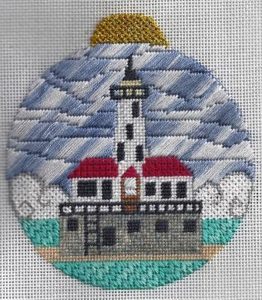
I learned this technique from Lois Kershner. The first step is to mark the lines for your irregular rows on your canvas using an extra-fine point marker safe for fabrics. I did not do this here, because it was black.
To mark the area, draw roughly horizontal lines across the canvas. These are not straight lines, but should vary in slope along their length. The important thing is to make them irregular. If you look at the picture you will see that they go up and down pretty much at random.
You will make several lines. Sometimes two lines will approach each other so they are only two stitches apart. Sometimes two lines will move apart from each other so they are six threads apart. Try not to make the lines farther apart than this, because longer stitches can be snagged too easily.
This is not the most sturdy of techniques. Partly this is because some of the stitches are quite long and snag easily. It is also because they tend to be a bit loose. This makes it hard to begin and end threads. The most secure way to do this is with a method borrowed from Japanese Embroidery called Securing L, below. Begin by bringing your needle from the back to the front of the canvas somewhere between two lines indicating rows. Hold onto a short tail on the back. Make a straight stitch over a single intersection and be sure to catch the tail. That’s one leg of the L. Make another straight stitch over one intersection at right angles to the first stitch, again catching the tail. You’ve made your L and the thread is secured. Use the same method to end your thread. The long Gobelin Stitches will cover the Securing L.

The first step is to start at either the bottom or top of the area and make a row of Upright Gobelin with uneven edges, below.

Once this is complete, make additional rows or partial rows, filling the area. The completed area will look like the picture aBOVe.
This is a great idea to use when the canvas will be done in Longstitch but you want to break up the larger areas. Because the rest of the canvas will be stitched in this technique, I chose Upright Gobelin for the stitch.
You can also do this technique with Diagonal Gobelin, as I did with the sky on this ornament from aSandy Grossman-Morris, below.

It’s the irregularity that makes these lines effective. As long as they move at random, so no two lines move the same way, and stay within these stitch lengths, your result will be unique and effective.
About Janet M Perry
Janet Perry is the Internet's leading authority on needlepoint. She designs, teaches and writes, getting raves from her fans for her innovative techniques, extensive knowledge and generous teaching style. A leading writer of stitch guides, she blogs here and lives on an island in the northeast corner of the SF Bay with her family

Leave a Reply